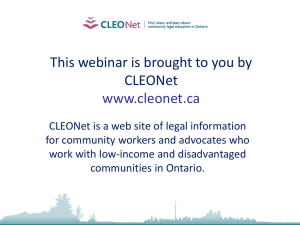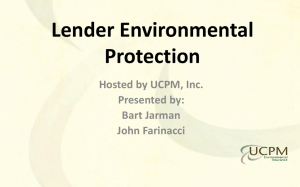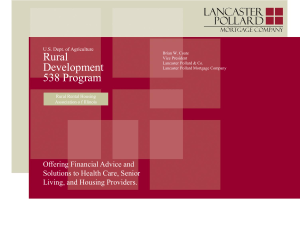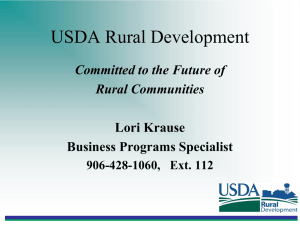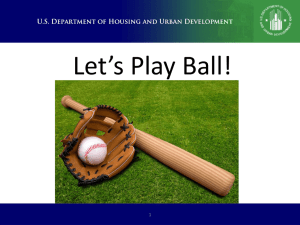Student Lending and Access to Higher Education: New Institutional
advertisement
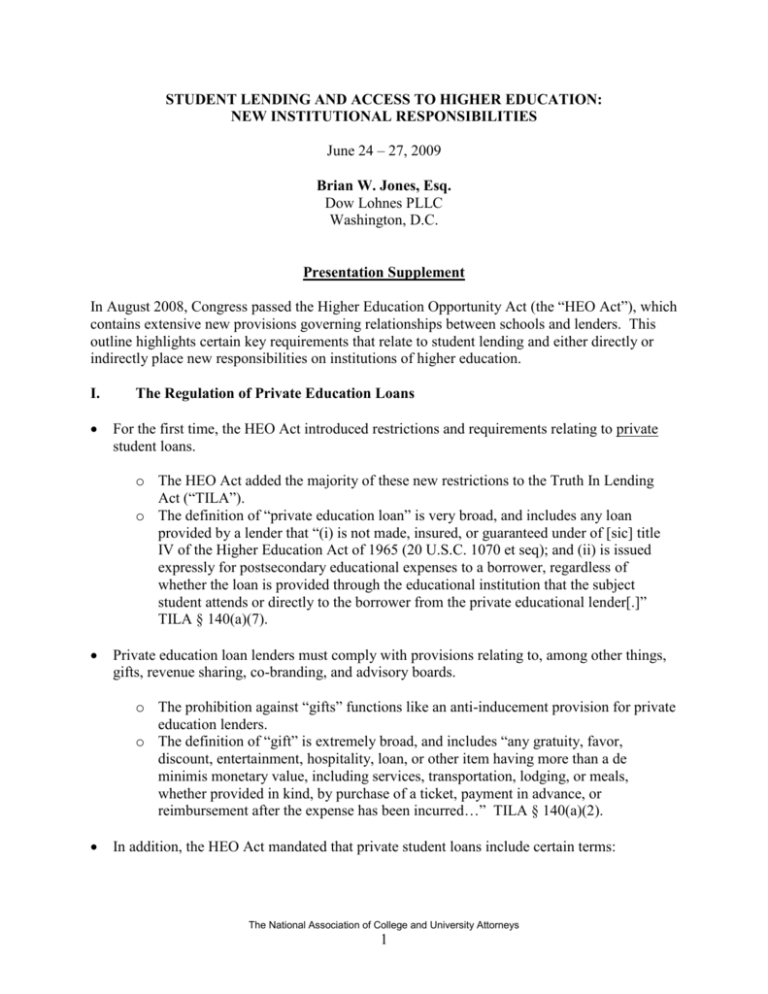
STUDENT LENDING AND ACCESS TO HIGHER EDUCATION: NEW INSTITUTIONAL RESPONSIBILITIES June 24 – 27, 2009 Brian W. Jones, Esq. Dow Lohnes PLLC Washington, D.C. Presentation Supplement In August 2008, Congress passed the Higher Education Opportunity Act (the “HEO Act”), which contains extensive new provisions governing relationships between schools and lenders. This outline highlights certain key requirements that relate to student lending and either directly or indirectly place new responsibilities on institutions of higher education. I. The Regulation of Private Education Loans For the first time, the HEO Act introduced restrictions and requirements relating to private student loans. o The HEO Act added the majority of these new restrictions to the Truth In Lending Act (“TILA”). o The definition of “private education loan” is very broad, and includes any loan provided by a lender that “(i) is not made, insured, or guaranteed under of [sic] title IV of the Higher Education Act of 1965 (20 U.S.C. 1070 et seq); and (ii) is issued expressly for postsecondary educational expenses to a borrower, regardless of whether the loan is provided through the educational institution that the subject student attends or directly to the borrower from the private educational lender[.]” TILA § 140(a)(7). Private education loan lenders must comply with provisions relating to, among other things, gifts, revenue sharing, co-branding, and advisory boards. o The prohibition against “gifts” functions like an anti-inducement provision for private education lenders. o The definition of “gift” is extremely broad, and includes “any gratuity, favor, discount, entertainment, hospitality, loan, or other item having more than a de minimis monetary value, including services, transportation, lodging, or meals, whether provided in kind, by purchase of a ticket, payment in advance, or reimbursement after the expense has been incurred…” TILA § 140(a)(2). In addition, the HEO Act mandated that private student loans include certain terms: The National Association of College and University Attorneys 1 o Acceptance and Lock-up Period: the borrower shall have the right to accept the terms of the loan and consummate the transaction at any time within 30 calendar days (or such longer period as the private educational lender may provide) following the date on which the application for the private education loan is approved and the borrower receives the [required] disclosure documents… and the rates and terms of the loan may not be changed by the private educational lender during that period. o Rescission right: the borrower may cancel the loan, without penalty, at any time within 3 business days of the date on which the loan is consummated. o No Prepayment Penalty: private educational lenders are expressly prohibited from imposing any fee or penalty on a borrower for early repayment or pre-payment of any private educational loan. Institutions offering institutional loan products may qualify as private education lenders. o Under the HEO Act, “private education lender” means: “(A) a financial institution, as defined in section 1813 of Title 12 that solicits, makes, or extends private education loans; (B) a Federal credit union, as defined in section 1752 of Title 12 that solicits, makes or extends private education loans; and (C) any other person engaged in the business of soliciting, making, or extending private education loans[.]” TILA § 140(a)(6) (emphasis added). o As private lenders, institutions would be required to comply with elements of TILA and Regulation Z, including considerable reporting and disclosure requirements and mandatory loan terms noted above. o This point is being discussed in Negotiated Rulemaking. Any institution providing prospective borrowers with information relating to private loans must disclose certain information to such borrowers. o Most significant of the new disclosures are the private loan informational forms being developed by the Federal Reserve Board (proposed forms published March 24, 2009, in 74 Fed Reg. 12464). II. Preferred Lender Arrangements Institutions are deemed to have entered into a “preferred lender arrangement” if they recommend, promote or endorse a lender that provides Title IV Program loans or private loans to the school’s students or their families. ED is suggesting in connection with Negotiated Rulemaking that anything beyond a historic lender list creates a preferred lender arrangement. o A “historic lender list” is a comprehensive list of lenders that have provided loans to the institution’s students over a set period of time (e.g., 3-5 years). According to ED, any subset of such a list of lenders, including based on volume, results in an implied endorsement and constitutes a preferred lender arrangement. The National Association of College and University Attorneys 2 Institutions that enter into a preferred lender arrangement must create a preferred lender list that satisfies specific criteria, including: o Separate lists for FFEL and private education loan lenders; o At least three unaffiliated lenders on an FFEL preferred lender list and two unaffiliated lenders on a private education loan preferred lender list; o Prominent disclosure of method and criteria used to select lenders on list; o A statement regarding why the institution chose to enter into preferred lender arrangements; and o Comparative loan information. Institutions that enter into a preferred lender arrangement also are subject to a host of additional requirements including: o Disclosures to borrowers and the public on the institution’s website and in any other publications, mailings, electronic messages, or materials that discuss financial aid opportunities; and o Annual Reporting to ED. III. The Federal Code of Conduct All institutions must adopt a Code of Conduct that includes specific provisions relating to: o o o o o o o Revenue-Sharing Arrangements; Gifts (Inducements); Certain Contracting Arrangements; Borrower Choice; Opportunity Pool Funds; Certain Staff Assistance; and Certain forms of Advisory Board Compensation. Sorting out the prohibited activities from the permissible is a challenge. The Code of Conduct statutes and the related regulations include certain “safe harbors,” much like the “permissible activities” list in the current regulations concerning prohibited inducements. o Institutions should closely scrutinize any lender services or activities that do not clearly fall within such safe harbors. IV. Federal preemption? State Codes of Conduct Many institutions also are subject to state laws, or state codes of conduct by which they have agreed to abide. Examples include: o Cuomo’s Code of Conduct The National Association of College and University Attorneys 3 o o o o V. SLATE Maryland College Loan Code of Conduct New Jersey Student Loan Code of Conduct Arizona Student Loan Code of Conduct In the absence of clear federal preemption, institutions must be prepared to comply with more restrictive state provisions. Status of Current Regulatory Efforts by ED ED promulgated new regulations in 2007, effective July 1, 2008, with new provisions relating to school-lender relationships. However, these regulations were promulgated before the HEO Act was passed and signed into law. Presently, ED is conducting a Negotiated Rulemaking, the result of which will be revised and expanded regulations that carry out the requirements of the HEO Act. VI. Practical Responses • • Routinely TRAIN financial aid office employees on rules of the road General Counsel should BE AWARE of and BE ENGAGED in what goes on in the FAO – you’d be surprised Periodically REVIEW DOCUMENTS distributed by the FAO PAY ATTENTION to regulatory developments ASK QUESTIONS • • • Brian W. Jones is an attorney with the Washington, D.C. law firm of Dow Lohnes PLLC, where he counsels educational institutions regarding compliance with a broad array of federal, state and accrediting agency regulations. He may be reached at (202) 776-2341 or bjones@dowlohnes.com. This document is intended to provide general information on certain provisions of the Higher Education Opportunity Act, but should not be considered legal advice. For such advice, readers should consult with qualified counsel familiar with their particular circumstances. The National Association of College and University Attorneys 4 Higher Education Act Reauthorization New Requirements Relating to Preferred Lender Arrangements The U.S. Department of Education (the “Department”) addressed for the first time “preferred” or “recommended” lender arrangements in the regulations that took effect July 1, 2008. The reauthorized Higher Education Act of 1965 (“HEA”) codifies in statute many of the elements introduced in those regulations, and also sets forth a host of additional requirements. To ensure compliance with these new requirements, schools will need to revisit their existing preferred lender relationships and, in particular, the manner in which they promote their preferred lenders. Following, we review certain key elements of the new law relating to preferred lender arrangements. We note, however, that it will be some time before the form and content of disclosures relating to preferred lender arrangements, including preferred lender lists, is completely settled. Congress has permitted the Department an 18-month window to determine the exact nature of the information that must be disclosed to prospective borrowers and their families. These and other issues are currently the subject of a negotiated rulemaking process being undertaken by the Department. In the interim, institutions should act in good faith, consult with counsel, and make every effort to comply with the new law. I. Preferred Lender Lists Under the new law, an institution, or any institution-affiliated organization, is deemed to have entered into a “preferred lender arrangement” if it recommends, promotes or endorses a lender that provides Title IV Program loans or private loans to the school’s students or their families. Any school party to preferred lender arrangements must, in turn, create a preferred lender list (or lists, if there are private loan lenders) disclosing such arrangements. Preferred lender lists must be updated annually, and made available to students and their families. As discussed below, the reauthorized HEA offers extensive commentary regarding the form and content of such preferred lender lists. Unaffiliated Lenders Significantly, the new law expands and revises the “unaffiliated lender rule.” The reauthorized HEA, like the existing regulations, requires each school’s preferred lender list to include at least three unaffiliated lenders. The new law further provides that where a school has a preferred lender list for private loans, it must ensure that the private loan preferred lender list includes at least two unaffiliated lenders. In addition, for each lender included on a preferred lender list, the school must indicate whether the lender is an affiliate of another lender on the list, and describe the details of any such affiliation. The National Association of College and University Attorneys 5 Interestingly, the new law shifts the burden of the “affiliate” determination from schools to the Department, a shift no doubt welcomed by the regulated community. Formerly, each school had to gather information from the lenders on its preferred lender list in order to determine such lenders’ affiliations. The reauthorized HEA, however, directs the Department to create a list of eligible lender affiliates, and instructs schools to use the most recent version of this list to determine whether any affiliations exist among their preferred lenders. Of course, until the Department’s list is available, schools will continue to shoulder the responsibility for determining whether lenders on their lists are affiliated. Method and Criteria The new law, like the regulations, also requires each institution to prominently disclose on the face of its preferred lender list the method and criteria it uses to select lenders for the list. The reauthorized HEA amplifies this requirement, stating that the discussion of method and criteria should demonstrate that lenders are selected on the basis of the best interest to the borrowers, and examine factors such as: payment of origination or other fees on behalf of the borrower; highly competitive interest rates, or other terms and conditions or provisions of loans under this title or private education loans; high-quality servicing for such loans; or additional benefits beyond the standard terms and conditions or provisions for such loans. The new law also introduces a separate requirement that each school articulate why it has chosen to enter into a preferred lender arrangement with the lenders on its lender list, “particularly with respect to terms and conditions or provisions favorable to the borrower.” This discussion should focus on articulating why the lenders on the list best satisfy the “method and criteria” the school uses to guide its selection. Minimum Information Relating to Loan Terms A significant element of the new law relating to preferred lender lists has not yet been finalized. Congress has directed the Department to determine what “minimum information” regarding Title IV loan terms and benefits schools should provide to prospective borrowers and their families in connection with preferred lender lists (“Minimum Information”). Congress has afforded the Department 18 months to decide the scope and content of the Minimum Information, and also to develop a model disclosure form institutions may use to disclose the Minimum Information. The reauthorized HEA suggests that the Minimum Information should include, among other things, the interest rate and terms and conditions of the lender’s loans for the next award year, including loan forgiveness and deferment, information on any charges, such as origination and Federal default fees, and the amount the borrower may pay in interest, based on a standard repayment plan. We anticipate that the Department’s ultimate determination will largely incorporate these suggestions. At this time, however, schools should continue to provide with The National Association of College and University Attorneys 6 their preferred lender lists the “comparative information regarding interest rates and other benefits” required under the existing regulations. Finally, schools will be pleased to note that under the new law, lenders are responsible for providing schools with the Minimum Information the Department ultimately determines should be disclosed. II. Additional Disclosures The reauthorized HEA directs schools to provide prospective borrowers and their families with a number of disclosures relating to preferred lender arrangements in addition to the information that must be included on the face of each school’s preferred lender list. Many of these additional disclosure requirements are placed upon institution-affiliated organizations, as well as the institutions, and include private loans within their scope. For example, an institution, or any organization affiliated with that institution, with a preferred lender arrangement must disclose on its website and in any other publications, mailings, electronic messages, or materials that discuss financial aid opportunities: the maximum amount of Federal grant and loan aid under title IV available to students; for each type of loan offered pursuant to a preferred lender arrangement, the Minimum Information relating to that loan; and a statement that the institution is required to process the documents required to obtain a Title IV loan from any eligible lender the student selects. If the institution, or affiliated entity, is party to a preferred lender arrangement involving private loans, it must also disclose in its financial aid publications, mailings, electronic messages, certain information specified in Section 128(e) of the Truth in Lending Act. Annual Report to the Secretary Significantly, the reauthorized HEA introduces a new annual reporting obligation for schools, and school-affiliated organizations. This report must be provided to the Department, made available to public, and provided to prospective and current students and their families. The information required to be included in the annual report is entirely duplicative of information that the new law requires schools to provide in connection with their preferred lender lists (see Section I, above), or as part of their general disclosure obligations. The National Association of College and University Attorneys 7 III. The Relationship Between the New Law, the Existing Regulations, and State Requirements Relating to Preferred Lender Arrangements As noted above, the Department has previously promulgated regulations governing preferred lender arrangements and lists, as well as related guidance. Schools should keep in mind that the requirements of the reauthorized HEA prevail over such regulations or guidance insofar as they conflict or are inconsistent with the new law. However, it is also true that the Department’s regulations and guidance will continue to be in effect unless they conflict or are inconsistent with the new law. Consequently, institutions should seek to comply first with the provisions of the reauthorized HEA, and then with the elements of the regulations and guidance that are consistent with the new law. A similar tact must be taken with state laws concerning preferred lender arrangements and lists. A basic principle of the American system of government is that Federal law supersedes state law. However, Congress has not declared any intention to completely pre-empt state regulation of higher education in general or preferred lender relationships in particular. As such, to the extent a state’s laws that regulate the activities of higher education institutions, including such things as preferred lender relationships, do not conflict with provisions of the new law, they will remain in effect. Conversely, if a state’s laws do conflict or are clearly inconsistent with any of the reauthorized HEA provisions or the existing regulations, the Federal law will prevail. IV. Contact Information Please contact Brian W. Jones, (202) 776-2341, bjones@dowlohnes.com or Aaron Lacey, (202) 776-2613, alacey@dowlohnes.com, if you have any questions regarding the matters discussed herein. The National Association of College and University Attorneys 8

